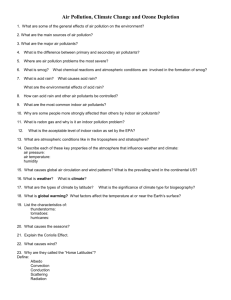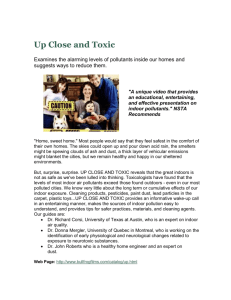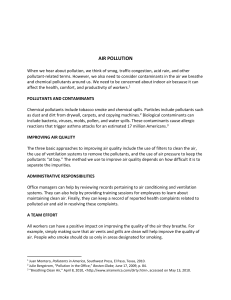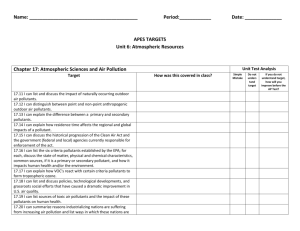IAA - TerpConnect - University of Maryland
advertisement
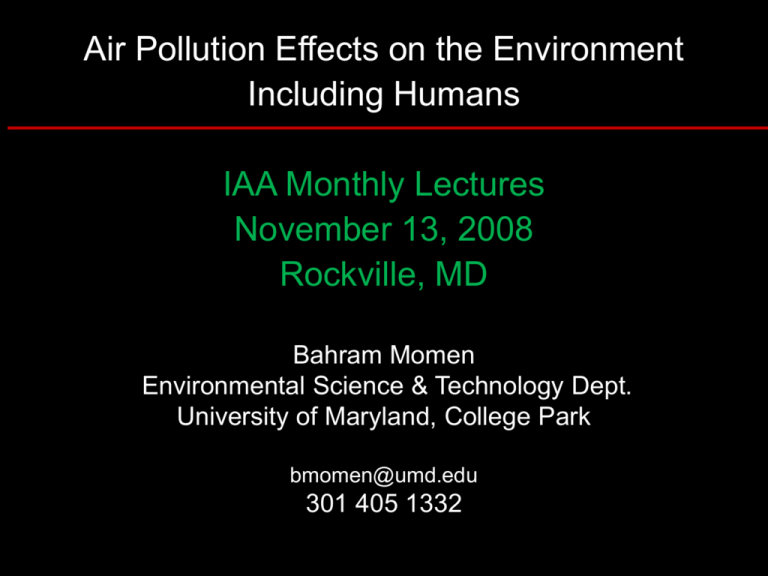
Air Pollution Effects on the Environment Including Humans IAA Monthly Lectures November 13, 2008 Rockville, MD Bahram Momen Environmental Science & Technology Dept. University of Maryland, College Park bmomen@umd.edu 301 405 1332 Air Pollution: Indoor and Outdoor I. Indoor Air Pollution (IAP) • Among top five risks to public health • Includes home & work environments • Up to five times worst than outdoor pollution • Worst in the developing countries • In developed countries people spend much time indoor • Air conditioning & heating with closed windows?? • 30% of buildings have IAQ (indoor air quality) problems (known as Sick Building Syndrome or SBS) • 25% of workers have problems with work environment affecting quality of their work • Associated pollutants: - Particulates, Microbes, Chemicals - Defining the relative impacts of each source is difficult due to individual genetic susceptibility and interactive effects of multiple pollutants - Difficult to come up with acceptable levels for all - Frequently the effects are considered through retrospective or anecdotal evidence Sources of IAP • Human activities and climate controls designed for comforts and/or efficiency • Energy efficient buildings • Reduced air exchange • Elevated humidity and temp. in microzones (e.g., bathrooms and kitchen) - increases mold growth - increases formaldehyde emission from manufactured material • Fossil fuel burning appliances, humidifiers, pesticides, construction material, etc. Kinds of IAP 1. Volatile Organic Compounds (VOC) •Contain carbon, hydrogen, oxygen, fluorine, chlorine, bromine, sulfur, nitrogen, etc. •May be very potent persisting indoor for a long time •Are easily vaporized at room temp. releasing noxious vapors •Are contained in household products for cleaning, disinfecting, degreasing, waxing, cosmetics, air fresheners, dry-cleaned fabrics •Research is lacking on short- and especially long-term effects of individual pollutants let alone their interactive effects 2. Pesticides •In the US, 80% of exposures to pesticide occurs indoor and up to 12 different pesticides can be found in a single home •75% of the US households report indoor use of at least one pesticide/yr •They include insecticides, termiticides, rodenticides, fungisides, microbial disinfectants formulated as sprays, foggers, liquids, sticks or powders •They aim to kill, and thus, are highly toxic •Exposure to pesticides accounts for about 80,000 poisoning of children /yr due to ingestion, but inhalation and dermal exposure also occur •Health risks: systematic illness, organ damage, respiratory irritation and disease, neurological disorders, headaches, nausea, dizziness 3. Construction material and furnishings • Asbestos historically used for insulation and fire-retardant (floor and ceiling tiles, counter tops, pluming, etc.) - its use has been banned and it is continued to be removed from older buildings during reconstruction or remodeling - If in good condition and undisturbed not a major risk? - Aerosolized fibers are very small and when respired can damage the lungs and abdominal lining leading to irreversible scarring and cancer 3. Construction material and furnishings … • Carpeting and related material (adhesives, padding) emit VOC and cause eye, nose, throat irritation, headaches, rashes, coughing, fatigue, shortness of breath - can also act as a sink for pesticides, dust mites, molds that are hard to clean and remove by vacuuming - fabrics, paints, furniture (pressed wood products) emit formaldehyde -- a carcinogen absorbed through nose and skin -- target levels < 0.1 ppm (some states 0.05 ppm) -- mobile homes are of particular concern because of high emitting amount and small interior space 3. Construction material and furnishings … Possible remedies: • High ventilation • Low humidity • Low temp. • Selection of low emitting material • Application of water repellant finishes • Older material have lower emission due to natural decay of toxins overtime 4. Combustion Products •Oil, gas, kerosene, wood, and coal (burned by appliances, space heaters, fireplaces, gas or wooden stoves) - If not properly vented, installed, or maintained, emit CO, NO2, particle and chemical irritants •CO (colorless, very dangerous) - Kills about 500 Americans /yr (symptoms: headache, chest pain, dizziness, weakness, nausea, vomiting, confusion •NO2; Colorless, irritant of the mucous membranes of the eye, nose, and throat - High exposure causes respiratory irritation, shortness of breath, respiratory infection and lung diseases 4. Combustion Products … •Tobacco smoking, about 46,000,000 American smoke - Contains 4000 chemicals, 200 known toxins, 69 known carcinogens - 75% of nicotine ends up in the atmosphere - Secondhand smoke contains higher concentration of toxic and carcinogens than smoke inhaled directly - Kills 3,000 non-smoking Americans through lung cancer 35,000 through heart disease 150,000 to 300,000 children < 18 yr through respiratory track infection - Children exposed to secondhand smoke are at higher risk of pneumonia, ear infection, bronchitis, coughing, wheezing, and asthma 5. Lead • In the late 20th century, the greatest environmental harm to children’s health in the US • Used widely in pluming material, gasoline, and paints until banned in 1960 • Can be transferred indoor from outdoor via dust, shoes, clothing, and pets • Lead particulates may be inhaled or ingested to be absorbed into the blood to be distributed to soft tissues and bone and eventually affect every system in the body • At levels > 80 mg /dL of blood convulsion, coma, and death can occur • Levels as low as 10 mg /dL can impair mental and physical development leading to lower IQ, ADD, increased behavioral problems, and damage to central nervous system, kidneys and blood cells 6. Radon • A colorless, odorless, radioactive gas released from natural decay of uranium, a common component of rocks, soil, and water • Radon enters homes through cracks, drains, and wells • Once inside can be trapped and increased in concentration while undetected • Its inhalation can cause lung cancer and death • Listed as the second leading cause of lung cancer in the US • About 21,000 deaths /yr can be prevented by addressing radon exposure (by individual blood testing - home radon reduction systems (by 99%) are available 7. Biological Pollutants • Bioaerosols are biological agents (e.g., bacteria, viruses, mold, mites, cockroach particles, pollen, animal dander and saliva) transmitted by air • Associated with allergies and asthma that have significantly increased worldwide during the last 30 yrs • Can persist in dust particles and animal droppings and/or proliferate in humid micro zones until becoming airborne • Natural breeze, air conditioning, system humidifiers, and active movements aid in the transfer of bioaerosol 7.1. Mold • Allergic reaction caused by direct exposure to spores and cell wall components or from the production of metabolites (microbial volatile organic compounds, mycotoxins) • Even nonviable mold fragments can initiate allergic reaction • Threshold levels are unknown and appear to depend on the type of mold and the individual 7.2. Endotoxin, Bacteria, and Viruses • Bacteria grouped into 2 classes depending on the chemical composition of their cell walls: Gram negative and Gram positive - Gram negative: have outer cell wall that contain LPS (lipopolysacharide - - fat and carbohydrate) -- as intact or fragmented bacterial cell-walls can cause adverse effects in humans and animals including fever, blood clothing, alteration of the behavior of white blood cells (reason to call it as endotoxin) -- found in household dust, easily airborne and inhaled to cause lung problems • Transmitted by sneezing and coughing, water use, direct contact or use of humidifiers, ventilation of heating & cooling systems • Infections increases in winter due to more indoor, closed door human activities • The US population suffers 1 billion colds/yr • Each season about 50 million Americans contract the flue and about 20,000-40,000 die/yr 7.3. Animal allergens •Tiny scales of skin constantly shed from animals (e.g., pets, rats, mice) and airborne •Animal urine and saliva proteins •15% of American allergic to cats or dogs and 2 million with cat allergies still keep cats 7.4. Arthropod allergens •House dust mites: - microscopic organisms related to spider and ticks - major pollutants of indoor air - cause non-seasonal allergy in about 20,000,000 Americans - present in all homes, in the house dust, bedding, and carpeting - Feeding on dead human skin and thrived under increased humidity •Cockroaches - highly adaptable to extreme conditions, - can be found everywhere (98% of urban homes) - cause asthmatic allergies 8. Plant allergens •Outdoor allergens such as pollen can enter indoor via pets, shoes, personal objects, open windows and doors •About 35,000,000 American suffer Factors affecting indoor pollution exposure •Identification of the source and level •Duration of exposure •Environmental maintenance •Assessing interactive effects of multiple pollutants 1. Exposure reduction • Education • Removal of the source • Following label information of household products and reduce their use • Ensure fuel-burning appliances are properly installed, operated, maintained (ventilated, serviced, etc.) • Reduce humidity 2. Building maintenance and operation •Properly installed and maintained heating, cooling and their ventilation systems can reduce indoor pollution and its transfer from outdoor and vise versa •Use of fungicide paint •Use of air purification systems 3. Building design •Sustainable and green building design •Sub-slab or plastic sheeting systems to remove radon •Crack and joint sealing •20 cubic feet per minute of outdoor air per person Sources of IAP In Developing countries … • Heating and cooking using biomass (wood, charcoal, crop residue, dung) and coal combustion • Leading cause of mortality and disease , mostly the poor • Disproportionately affecting women and children Improvements are easy and inexpensive… • Improving stoves for more efficient combustion and better ventilation • Appropriate chimney • Separating kitchen from living areas • Better education on oven use • Using Solar Ovens (http://www.solarovens.org/) > no photo-cell > clean heat > for regions with abundant solar radiation > with or without reflectors - less than US $200 - 210-320 oF depending on the sun’s angle and use of reflectors II. Atmospheric Pollution • Major public, scientific, and policy concern, subject of extensive research • Atmosphere: a mixture of gases and particles • Air pollutant: any substance in air that, in high enough concentrations > harming ecosystems and their components (human, animals, vegetation, etc.), or materials (e.g., buildings, monuments, etc.) > reducing visibility??? • Early accounts due to smoke from burning wood and coal as well as lead mining in ancient Greece and Rome • King Edward I of England in the 13th century prohibited use of sea coal that produced soot and sulfur dioxide over London • Industrial revolution and fossil fuel burning increased air pollution exponentially • In 1948, the first Air pollution disaster in the US occurred and 20 lives were lost as a result of industrial pollutants trapped in very stable air over Donora, PA • In 1952, a week coal burning & stagnant air resulted in severe smog over London to kill 12,000 in 3 months • All major metropolitan areas now suffer, especially in valleys (e.g., Mexico City) or along coastal mountain ranges (e.g., Los Angeles) • Air pollutants can be found throughout the troposphere but those closer to the earth surface with high concentrations are of primary concerns •Pollutant concentrations depend mostly on - total mass emission - Atmospheric condition that affects the pollutants fate and transport, e.g., -- warm, sunlit air + NOx + carbohydrates (O3 formation) - Vertical and horizontal air movements (dry deposition) - Rain and snow (wet deposition, acid rain) • Effects on human and ecosystem health: not fully understood • Costs: associated with prevention, removal, treatment, etc., not fully understood Primary Atmospheric Pollutants The US-EPA designates 6 types of primary pollutants for regulatory purposes: •Carbon monoxide •Hydrocarbons •Particulate matter •Sulfur dioxide •Nitrogen oxides •Lead •Carbon dioxide (CO2)??? • Carbon monoxide (CO) Highly poisonous, colorless, odorless Exists in urban air Constitutes 60% of primary pollutants 50% produced from incomplete combustion of fossil fuels in cars and trucks Is part of cigarette smoke Has few natural sources Relatively stable but short-lived in the atmosphere (converts to CO2) Is decreasing due to increasing fuel efficiency and using oxygenated gas and ethanol • Hydrocarbons (HCs) or Volatile Organic Carbons (VOCs) Methane (CH4) the most abundant of HCs), a green house gas produced by farm waste, garbage decomposition, cows VOCs are non-methane HCs including: - Benzene and their derivatives such as formaldehyde - HCs contributes to O3 production - Large portion produced by anthropogenic activities (fossil fuel burning, gasoline evaporation) - Produced naturally from decomposition of organic matter and some plants (pines, creosote bushes) •Particulate matter Includes solid particulates or liquid droplets small enough to remain suspended in air (soot, smoke, dust, asbestos fibers, pesticides, S and N compounds, Hg, Fe, Cu, Pb) They can reach stratosphere and block sunlight –cooling effect In the troposphere can lead to respiratory illnesses, acid rain, decreased visibility, etc. In the US about 60% come from roads and transportation 25% agriculture, forestry, and fire •Sulfur dioxide 90% of its emission comes from fossil fuel (coal, gasoline, etc.) Ore smelters and oil refineries are other sources Causes respiratory illness, acid rain with adverse effects on all components of the ecosystem and buildings •Nitrogen oxides (NOX) Formed mainly from N2 and O2 during high-temperature combustion of fossil fuel in engines (catalytic converters are used to reduce NOx) Contributes to heart and long problems and acid rain and O3 formation Natural sources include metabolic activities of soil bacteria • Lead Highly toxic From leaded gasoline and paint in the past Secondary Pollutants •Formed during chemical reaction between primary pollutants and other atmospheric constituents such as water vapor •Reactions generally occurs in sunlight to produce photochemical smog •Composed mainly of O3 > Favorable condition for O3 formation: air temp exceeding 32 oC, low wind, intense radiation, low precipitation > Many US cities exceed the EPA standard (80 ppb for one hour per day averaged over 3 years) > Not limited to urban areas anymore > Affects all living things (humans, plants, etc.) Other pollutants •EPA has identified about 188 other chemicals that are considered to be hazardous air pollutants (HAPs) Pollutants with Radioactive Effects •Green House gases: CO2, CH4, N2O, CFCs, H2O, and O3 I. Green house gases (CO2, CH4, etc.) - increased CO2 not considered pollution by some due to an incorrect perception that increased CO2 can enhance vegetation growth Sources: • Natural: biological and chemical processes • Anthropogenic: fossil fuel combustion •Sources: Are many, including - May natural and/or anthropogenic: Cars, industry, wind erosion of soil, natural processes (e.g., volcanic ash), agriculture, forestry practices, development) - In both gases and particulate forms from fixed or mobile sources II. Acidic deposition (wet & dry?) • Sulfur compounds: regulations have decreased their emissions & depositions(?) • Nitrous Oxides (NOx): les strict regulation for N than S (?) and thus, N deposition is gaining importance in acidification Sources: • Natural: biological decay • Anthropogenic: fossil fuel combustion III. Ozone (O3), two contrasting issues 1. Decreased in the stratosphere (15-50 km) where needed to shield against harmful solar rays - decreased mostly by CFCs whose production has been phased out (an international successful effort) 2. Increased in the troposphere (0-15 km) where adversely affects all living things! - increased mostly by photochemical reaction of Nox and VOC Concerns • Extent of anthropogenic vs. natural pollution • Complexities involved in studying and documenting the effects of even individual air pollutants OZONE - decrease + increase plant cells via stomates - cell-wall oxidizes & degrades large molecules N release N moves to: wood? roots? rhizosphere? N saturation? N resynthesis + surface area & surface tension costly + Rs beneficial + An - stomatal cond. + + [cellular] - An - leaf area + foliar C:N herbivory? litter C:N? decomposition? elasticity - w, s, - + & TLP GROWTH + p • Multifaceted effects especially on > Ecosystem & human Health - effects of CO2, O3, N, acid rain, etc. > Sustainable economic development > Sustainable industrial development > Climate Change • Links among pollutants • Individual and interactive effect of pollutants on the systems affected > e.g., reversal of some short-term, positive effect of elevated CO2 on vegetation by elevated tropospheric O3 > e.g., synergistic effect of O3 & N deposition on N saturation, that can affect water quality & endanger ecosystems stability > complexities involved in setting standards Stratospheric Pollution •CFCs, O3, UVB, and 1987 Montreal Protocol Cutting edge research • Scientists at MIT have found that > nano-structural organization of concrete determines its strength not the material itself - concrete used in developed and developing countries account for 5-10% of the worlds total CO2 emission - using Mg instead of Ca can provided same nanostructural strength under lower temp. leading to producing concrete with 10% less CO2 emission • Geo-thermal energy currently being employed in California, Hawaii, Utah, and Nevada • MIT scientists are also working on a more efficient use of geo-thermal energy with initial optimistic results • Scientists (Farrel et al. Science, 2006) have shown drastic benefit from transition to cellulose-based from cornedbased ethanol • Sugar cane/corn Bio-fuel, palm oil > advantages/disadvantages in terms of - energy cost to produce - fertilization - clear-cutting tropical forest • Wind, solar, hydro-energy Concluding Remarks •Air pollutants are > by-product of increased population, standard of living, & industrialization > anthropogenic cause of global warming & climate change > more expensive, and often impossible to eliminate or reduce, for developing countries in need of sustainable development, technology transfer, etc. Concluding Remarks •Air pollutants may be generated locally but they > do not stay local > do not respect human-set boundaries and borders > affect polluters and non-polluters alike • “We are not inherited the natural resources from past generations; rather we are borrowing them from our children” • “The nature will take care of itself, but it does not guarantee that we will stay a part of it”
